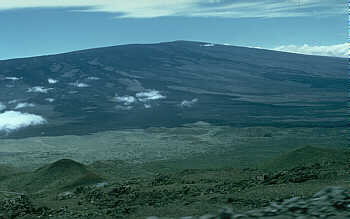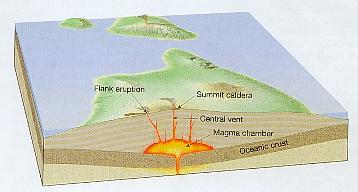Shield
Volcanoes
 Shield
volcanoes are volcanic mountains built up by the eruption of
fluid, basaltic lava flowing out of a central vent. They
have broad bases with very gentle slopes, and are the
largest volcanoes on Earth. The volcano gets its name from
its resemblence to the slightly domed shape of a warrior's
shield. The largest volcano in the solar system is Olympus
Mons, a shield volcano on Mars. It rises to an incredible
height of 24 km (15 miles), and its base is so large it
would cover almost the entire state of Missouri. The largest
shield volcano on Earth is Mauna Loa in Hawaii which rises
from its base on the seafloor to a height of 17 km (10.5
miles). Mt. Everest, by comparison, rises only a little over
8 km (5 miles) above sea level. Shield
volcanoes are volcanic mountains built up by the eruption of
fluid, basaltic lava flowing out of a central vent. They
have broad bases with very gentle slopes, and are the
largest volcanoes on Earth. The volcano gets its name from
its resemblence to the slightly domed shape of a warrior's
shield. The largest volcano in the solar system is Olympus
Mons, a shield volcano on Mars. It rises to an incredible
height of 24 km (15 miles), and its base is so large it
would cover almost the entire state of Missouri. The largest
shield volcano on Earth is Mauna Loa in Hawaii which rises
from its base on the seafloor to a height of 17 km (10.5
miles). Mt. Everest, by comparison, rises only a little over
8 km (5 miles) above sea level.
 Shield
volcanoes do not erupt violently. Rather, fluid, basaltic
lava erupts onto the surface and flows freely across the
ground for great distaces forming a broad cone. Lava tubes
can form beneath the surface of the lava flow which allows
the lava to flow for tens of kilometers (miles) without
cooling. Each successive flow increases the size of the
shield volcano. Shield
volcanoes do not erupt violently. Rather, fluid, basaltic
lava erupts onto the surface and flows freely across the
ground for great distaces forming a broad cone. Lava tubes
can form beneath the surface of the lava flow which allows
the lava to flow for tens of kilometers (miles) without
cooling. Each successive flow increases the size of the
shield volcano.
Photo Credit: D.
Little, USGS
Illustration Credit: Lutgens, F./Tarbuck, E., FOUNDATIONS OF
EARTH SCIENCE, 2/e, © 1999
Electronically reproduced by permission of Prentice Hall,
Upper Saddle River, New Jersey.
|
 Photoglossary
Photoglossary Photoglossary
Photoglossary